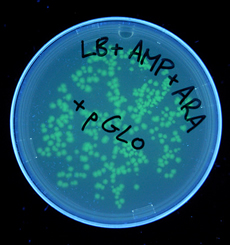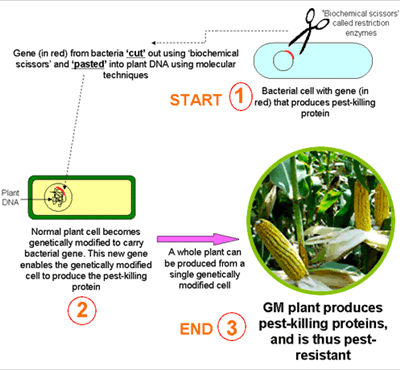Agriculture
Bacteria may be genetically modified through the introduction of recombinant DNA molecules into their cells. Such bacteria may be used to produce human insulin or introduce disease-resistant genes into plants, as well as numerous other applications.
The ability to genetically engineer bacteria is the outcome of several independent discoveries. In 1944 Oswald Avery and his coworkers demonstrated gene transfer among bacteria using purified DNA (deoxyribonucleic acid), a process called transformation.
In the 1960?s the discovery of restriction enzymes permitted the creation of hybrid molecules of DNA. Such enzymes cut DNA molecules at specific sites, allowing fragments from different sources to be joined within the same piece of genetic machinery.
Restriction enzymes are not specific in choosing their target species. Therefore, DNA from any source, when treated with the same restriction enzyme, will generate identical cuts. The treated DNA molecules are allowed to bind with one another, while a second set of enzymes called ligases are used to fuse the fragments together.
The recombinant molecules may then be introduced into bacteria cells through transformation. In this manner, the cell has acquired whatever genetic information is found in the DNA. Descendants of the transformed cells will be genetically identical, forming clones of the original.
Bacterial Plasmids
The most common forms of genetically altered DNA are bacterial plasmids, small circular molecules separate from the cell chromosome. Plasmids may be altered to serve as appropriate vectors (carriers of genetic material) for genetic engineering, usually containing an antibiotic resistance gene for selection of only those cells that have incorporated the DNA. Once the cell has incorporated the plasmid, it acquires the ability to produce any gene product encoded on the molecule.
The first such genetically altered bacteria used formedical purposes, Escherichia coli, contained the gene for the production of human insulin. Prior to creation of the insulin-producing bacterium, diabetics were dependent upon insulin purified from animals. In addition to being relatively expensive, insulin obtained fromanimals produced allergic reactions among some individuals.
Insulin obtained from genetically altered bacteria is identical to that of human insulin. Subsequent experiments also engineered bacteria able to produce a variety of human proteins, including human growth hormone, interferon, and granulocyte colony-stimulating factor.
Use in Plants
Genetically modified bacteria may also serve as vectors for the introduction of genes into plants. The bacterium Agrobacterium tumefaciens, the cause of the plant disease called crown gall, contains a plasmid called Ti.
Following infection of the plant cell by the bacterium, the plasmid is integrated into the host chromosome, becoming part of the plant?s genetic material. Any genes that were part of the plasmid are integrated as well. Desired genes can be introduced into the plasmid, promoting pest or disease resistance.
In April of 1987 scientists in California sprayed strawberry plants with genetically altered bacteria to improve the plants? freeze resistance, marking the first deliberate release of genetically altered organisms in the United States to be sanctioned by the Environmental Protection Agency (EPA).
The release of the bacteria climaxed more than a decade of public debate over what would happen when the first products of biotechnology became commercially available.
Fears centered on the creation of bacteria that might radically alter the environment through elaboration of gene products not normally found in such cells. Some feared that so-called super bacteria might be created with unusual resistance to conventional medical treatment.
Despite these concerns, approval for further releases of genetically altered bacteria soon followed, and the restrictions on release were greatly relaxed. By 2002, permits for field tests of hundreds of genetically altered plants and microorganisms had been granted.
- Biotechnology
BiotechnologyBiotechnology is the use of living organisms, or substances obtained from those organisms, to produce processes or products of value to humanity, such as foods, high-yield crops, and medicines. Modern biotechnological advances have provided...
- Genetically Modified Foods
Genetically Modified FoodsApplications of genetic engineering in agriculture and the food industry could increase world food supplies, reduce environmental problems associated with food production, and enhance the nutritional values of certain foods....
- 8 Reasons Gmos Are Bad For You
Genetically modified organisms, or GMOs, are created when a gene from one species is transferred to another, creating something that would not be found in nature. A large percentage of domestic crops (up to 85% of soybean yields) have DNA that was tweaked...
- Why Gmos Are Dangerous?
Genetically modified organisms (GMO?s) are a broad group of plants, animals, and bacteria that are engineered for a wide variety of applications ranging from agricultural production to scientific research. The types of potential hazards posed by GMO?s...
- Genetically Modified Crops Pass Benefits To Weeds
Herbicide resistance could confer an advantage on plants in the wild. Jane Qiu A genetic-modification technique used widely to make crops herbicide resistant has been shown to confer advantages on a weedy form of rice, even in the absence of the herbicide....
Agriculture
Genetically Modified Bacteria
 |
| Genetically Modified Bacteria |
The ability to genetically engineer bacteria is the outcome of several independent discoveries. In 1944 Oswald Avery and his coworkers demonstrated gene transfer among bacteria using purified DNA (deoxyribonucleic acid), a process called transformation.
In the 1960?s the discovery of restriction enzymes permitted the creation of hybrid molecules of DNA. Such enzymes cut DNA molecules at specific sites, allowing fragments from different sources to be joined within the same piece of genetic machinery.
Restriction enzymes are not specific in choosing their target species. Therefore, DNA from any source, when treated with the same restriction enzyme, will generate identical cuts. The treated DNA molecules are allowed to bind with one another, while a second set of enzymes called ligases are used to fuse the fragments together.
The recombinant molecules may then be introduced into bacteria cells through transformation. In this manner, the cell has acquired whatever genetic information is found in the DNA. Descendants of the transformed cells will be genetically identical, forming clones of the original.
 |
 |
Bacterial Plasmids
The most common forms of genetically altered DNA are bacterial plasmids, small circular molecules separate from the cell chromosome. Plasmids may be altered to serve as appropriate vectors (carriers of genetic material) for genetic engineering, usually containing an antibiotic resistance gene for selection of only those cells that have incorporated the DNA. Once the cell has incorporated the plasmid, it acquires the ability to produce any gene product encoded on the molecule.
The first such genetically altered bacteria used formedical purposes, Escherichia coli, contained the gene for the production of human insulin. Prior to creation of the insulin-producing bacterium, diabetics were dependent upon insulin purified from animals. In addition to being relatively expensive, insulin obtained fromanimals produced allergic reactions among some individuals.
 |
| Bacterial Plasmids |
Insulin obtained from genetically altered bacteria is identical to that of human insulin. Subsequent experiments also engineered bacteria able to produce a variety of human proteins, including human growth hormone, interferon, and granulocyte colony-stimulating factor.
Use in Plants
Genetically modified bacteria may also serve as vectors for the introduction of genes into plants. The bacterium Agrobacterium tumefaciens, the cause of the plant disease called crown gall, contains a plasmid called Ti.
Following infection of the plant cell by the bacterium, the plasmid is integrated into the host chromosome, becoming part of the plant?s genetic material. Any genes that were part of the plasmid are integrated as well. Desired genes can be introduced into the plasmid, promoting pest or disease resistance.
In April of 1987 scientists in California sprayed strawberry plants with genetically altered bacteria to improve the plants? freeze resistance, marking the first deliberate release of genetically altered organisms in the United States to be sanctioned by the Environmental Protection Agency (EPA).
 |
| Use in Plants |
The release of the bacteria climaxed more than a decade of public debate over what would happen when the first products of biotechnology became commercially available.
Fears centered on the creation of bacteria that might radically alter the environment through elaboration of gene products not normally found in such cells. Some feared that so-called super bacteria might be created with unusual resistance to conventional medical treatment.
Despite these concerns, approval for further releases of genetically altered bacteria soon followed, and the restrictions on release were greatly relaxed. By 2002, permits for field tests of hundreds of genetically altered plants and microorganisms had been granted.
- Biotechnology
BiotechnologyBiotechnology is the use of living organisms, or substances obtained from those organisms, to produce processes or products of value to humanity, such as foods, high-yield crops, and medicines. Modern biotechnological advances have provided...
- Genetically Modified Foods
Genetically Modified FoodsApplications of genetic engineering in agriculture and the food industry could increase world food supplies, reduce environmental problems associated with food production, and enhance the nutritional values of certain foods....
- 8 Reasons Gmos Are Bad For You
Genetically modified organisms, or GMOs, are created when a gene from one species is transferred to another, creating something that would not be found in nature. A large percentage of domestic crops (up to 85% of soybean yields) have DNA that was tweaked...
- Why Gmos Are Dangerous?
Genetically modified organisms (GMO?s) are a broad group of plants, animals, and bacteria that are engineered for a wide variety of applications ranging from agricultural production to scientific research. The types of potential hazards posed by GMO?s...
- Genetically Modified Crops Pass Benefits To Weeds
Herbicide resistance could confer an advantage on plants in the wild. Jane Qiu A genetic-modification technique used widely to make crops herbicide resistant has been shown to confer advantages on a weedy form of rice, even in the absence of the herbicide....


